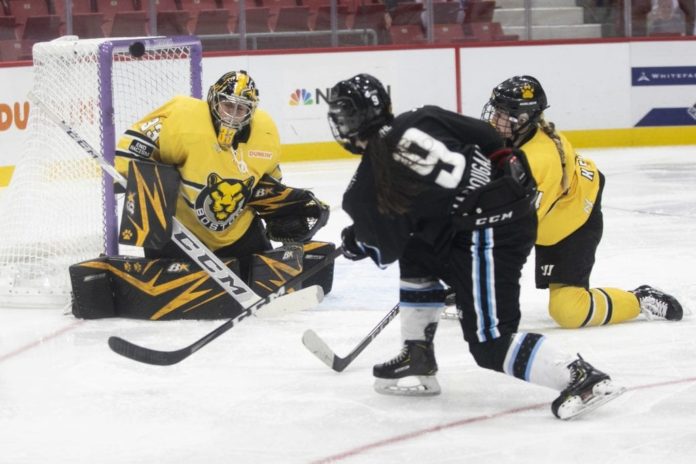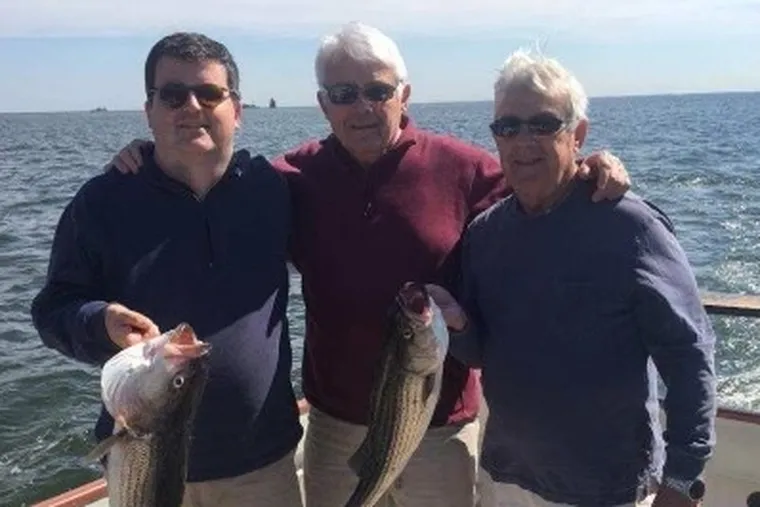The NWHL’s two-week tournament at Lake Placid was cut short after a Covid-19 outbreak that left a lot of questions.
Failings to internally communicate, transparency, prioritizing player safety, and protecting Black players against racist attacks became clear in the league’s attempt at a season. While the past year has brought unprecedented growth for the NWHL in terms of eyes on the game and sponsorships, it also exposed aspects of the league that wasn’t ready to handle the next level of notoriety and visibility. Journalists closer to the situation have already written their assessments and there’s no shortage of insightful suggestions as to where the league needs to improve. I, of course, have my own range of thoughts I hope to write about in the next few weeks. But a suggestion that shouldn’t be the first answer in anyone’s mind is the NHL.
Pleads for the NHL to save women’s hockey aren’t new. They come from former players like Cassie Campbell-Pascall to think pieces following the CWHL collapse all the way through the next week. With all due respect to any actual players who hope for an NHL partnered future because they believe it’s the quickest way to getting to play full-time hockey as a job and paid for it, which is understandable, understanding where journalists who rarely cover the women’s game are coming from with this is harder.
Let’s start from the past two weeks and work our way back. Season Six of the NWHL isn’t proof women’s hockey needs men’s hockey’s support, if anything, it’s an argument against it.
If the NWHL had the NHL’s monetary backing, and IF (big if) players were paid full-time salaries, they likely would have been able to quarantine two weeks before which would circumvent the one big failing in the NWHL’s bubble that made it not really a bubble.
However, NHL backing likely means NHL’s control in at least a portion of management or influence in the leagues’ decisions. NHL players are currently exempt from getting paid their salary unless they or an immediate family member has a medical condition, which makes it harder for players to opt-out. For the NWSL, a league similar to the NWHL in youth, all contracted players being paid regardless of if they took the risk of playing in the pandemic was crucial both to player safety and worker’s rights.
Additionally, the option for the Connecticut Whale to leave the bubble when they felt their players were at risk and the acceptance of that decision by the league would likely not have been so smooth. If positive tests started to roll in when they did in this alternate universe, it’s much harder to imagine that the NWHL would have canceled before the televised semifinal with the NHL on the line. One only has to look at the 100 person list of NHL players on COVID protocol while the league plays on for confirmation.
One could argue that positive tests and the need for the Whale to withdrawal wouldn’t have happened if the NWHL had NHL backing, consider their own successful playoff bubble last season. While the NHL did in fact pull off a successful bubble, it’s a big assumption to prove they would have put the same money, time, and care into women’s hockey when the expected revenue at the moment is nowhere near as high and they’re losing a lot of money on the NHL. Most women’s hockey fans, and women’s sports fans in general, know that it takes investing and room for growth to reap the rewards and revenue of women’s sports. Men’s leagues and business owners are historically not as smart; look no further than the Pegula’s, who threw a lot of money at the Buffalo Beauts for only a season before selling the team back and having no further involvement with either the NWHL or PWHPA.
The NHL’s bubble also did not come without its own problems. Players were promised they would be reunited with their families at the conference finals, only to find out the league had made almost no arrangement for families to do this safely and in border compliance. One player told ESPN “We were like, ‘I thought this was all figured out already. What do you mean we have limited available rooms?’ You told us families are allowed to come…That should have been done a long time ago so people could make plans.”
Players in Edmonton also complained that they barely went outside for days at a time and had to pay for a lot of their meals. Compare this to the NWSL, who doesn’t have as much money as the NHL, but had accommodations from their Challenger Cup bubble like no questions asked player compensation that allowed stars to opt-out without pushback, or contracting a coffee truck when players asked. While complaints on food or fly fishing as written in ESPN are small issues compared to safety and a full-time wage, it demonstrates that the NHL was willing to walk back on a lot of its promises. What it would try to get away with helping a league a lot more dependent on its money, who’s not producing as much revenue, with misogyny at play.
Requests for the NHL to be the savior of women’s hockey go far beyond the bubble situation, though. A lot of it relies on the assumption that NHL involvement with women’s hockey would come with better salaries, better conditions, better marketing, and teams. But is that really true? For how an NHL partnership, co-ownership, or another financial backing may look for the NWHL or PWHPA in North America’s current economic crisis, look no further than the AHL. Players received pro-rated salaries this season, were not sure what their salary would be when the season’s start was on the horizon, and went nine months without playing and receiving paychecks.
Director of the Professional Hockey Players Association, Larry Landon, asked for an 8 million dollar credit line to help his players before saying “The players should be healthy and happy, not struggling to make ends meet. I understand economic realities in conjunction with the NHL and the trickle-down to the NHLPA, but we need help, the players want to play. That’s not the issue. But the situation they’re facing is not palatable. We’re in a terrible situation. We need help. We’re not just asking for it. We’re begging.” In the same New York Post article, it was estimated most players would earn a pre-tax salary of $35,853 this season – just above where a 15 dollar minimum wage lands people annually if working full time.
The treatment of the AHL comes with the knowledge that they are a league full of future NHL players and stars like Trevor Zegras or Quinton Byfield. Names the NHL hopes to eventually profit off and therefore has the incentive to make sure they still play. For women’s hockey, the NHL has a lot less on the line even if they financially backed them, and therefore a lot less investment in their survival. For a league that has blacklisted players in the past decade for being vocal in their union and in CBA negotiations, one can only wonder how women’s players would be treated if they spoke out.
Neither the NWHL nor PWHPA are doomed, and both can grow as well as work out any existing problems without the NHL’s help. If anything, we can assume based on the aforementioned treatment of their own players that the NHL would only get in the way. Both leagues have seen a sponsorship boom within the past year including Dick’s Sporting Goods (NWHL), Discover (NWHL), Secret (PWHPA.) While the NHL as a whole may not be helpful, individual franchises and team owners can be as proved by the Minnesota Wild’s partnership with the Minnesota Whitecaps, the Toronto Maple Leafs with the PWHPA, or the Boston Bruins partnership with the Boston Pride. The New York Rangers took an additional step by offering support to both the NWHL and PWHPA.
No one is against individual NHL franchise investing in NWHL teams or leagues, and in the PWHPA’s case, a handful of owners form their own board of governors to start a league alongside the PWHPA’s leadership. But as for a model similar to the early NBA and WNBA, could an organization that is always three steps behind its peers in the MLB, NFL, and NBA, with a struggle to market its own game and constant concessions made by players, the best place to grow the women’s game? Especially when they have given excuse after excuse not to?
There is no shortage of improvements the NWHL has to make following this two-week tournament and no shortage of coverage of it. They need to do better, and as they’ve grown as a league, the expectations are higher in communications and playing standards. But the idea that the NHL is the solution to those problems is off base. The NHL ran into and is running into a lot of the same problems the NWHL did – lack of communication, failure to protect players from covid – they just have more money and PR to keep the whole league from stopping. I do wonder, if when we see multiple men’s teams suspending play currently because of COVID and the conditions in their bubble that was complained about, what would happen if someone said we hope they’d hurry up and fold so the NWHL or PWHPA can save them.
For more hockey thoughts and opinions from Kacey, check out their author page or Twitter.
For more NWHL content from Sports Are From Venus, click here.
Photo Credit: Michelle Jay
Credit: Source link































